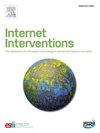在主动监测期间为低风险前列腺癌患者开发数字社会心理支持项目
IF 4.1
2区 医学
Q1 HEALTH CARE SCIENCES & SERVICES
Internet Interventions-The Application of Information Technology in Mental and Behavioural Health
Pub Date : 2025-06-25
DOI:10.1016/j.invent.2025.100853
引用次数: 0
摘要
背景主动监测(AS)是低至中危前列腺癌患者的首选治疗方法,但其社会心理影响存在挑战。本研究采用设计思维开发了一个数字化的社会心理支持项目,旨在改善男性AS患者的生活质量和健康状况。方法设计过程分为五个阶段:移情、定义、构思、原型和测试。进行利益相关者访谈以生成问题陈述。构思阶段的头脑风暴将自我管理应用程序概念化,并开发了应用程序功能的框架。原型是在与最终用户和专家的密切合作下开发的。测试阶段包括启发式评估和来自患者和医疗保健提供者的反馈。结果共情阶段的访谈强调了个性化护理、及时信息以及整体和量身定制的支持的必要性。明确的问题陈述旨在减少阿斯伯格综合症第一年的心理社会负担和改善应对机制。构思涉及多学科头脑风暴会议,最终产生了自我管理应用程序的概念,该应用程序具有信息、预约准备、医疗结果自我报告、生活方式指导、放松练习和通信工具等功能。开发了一个原型应用程序。测试显示了导航和设计方面的优势,并提供了改进错误处理和帮助文档的建议。反馈导致了改进,增强了可用性和临床集成。结论本研究开发了一种以患者为中心的自我管理应用程序来解决AS患者的社会心理挑战。通过促进参与、自我效能和沟通,该工具旨在改善前列腺癌管理的结果。未来的临床研究将评估其有效性。本文章由计算机程序翻译,如有差异,请以英文原文为准。
Developing a digital psychosocial support program for men with low-risk prostate cancer during active surveillance
Background
Active surveillance (AS) is a preferred treatment for men with low- to intermediate-risk prostate cancer, but its psychosocial impact presents challenges. This study used design thinking to develop a digital psychosocial support program aimed at improving quality of life and health outcomes for men on AS.
Methods
The design process followed five phases: Empathy, Define, Ideate, Prototype, and Test. Stakeholder interviews were conducted to generate a problem statement. Brainstorming in the ideation phase conceptualized a self-management application and a framework of the application's features was developed. A prototype was developed in close collaboration with end-users and experts. The testing phase included heuristic evaluations and feedback from patients and healthcare providers.
Results
Interviews during the empathy phase highlighted the need for personalized care, timely information, and holistic and tailored support. The defined problem statement aimed at reducing the psychosocial burden and improving coping mechanisms during the first year of AS. Ideation involved multidisciplinary brainstorming sessions, resulting in the concept of a self-management application with features such as information, appointment preparation, self-reporting of medical results, lifestyle guidance, relaxation exercises, and communication tools. A prototype application was developed. Testing showed strengths in navigation and design, with recommendations for improving error handling and help documentation. Feedback led to refinements enhancing usability and clinical integration.
Conclusion
This study developed a patient-centered self-management application to address psychosocial challenges in AS. By fostering engagement, self-efficacy, and communication, the tool aims to improve outcomes in prostate cancer management. Future clinical studies will evaluate its effectiveness.
求助全文
通过发布文献求助,成功后即可免费获取论文全文。
去求助
来源期刊

Internet Interventions-The Application of Information Technology in Mental and Behavioural Health
Medicine-Health Informatics
CiteScore
6.50
自引率
9.30%
发文量
94
审稿时长
6 weeks
期刊介绍:
Official Journal of the European Society for Research on Internet Interventions (ESRII) and the International Society for Research on Internet Interventions (ISRII).
The aim of Internet Interventions is to publish scientific, peer-reviewed, high-impact research on Internet interventions and related areas.
Internet Interventions welcomes papers on the following subjects:
• Intervention studies targeting the promotion of mental health and featuring the Internet and/or technologies using the Internet as an underlying technology, e.g. computers, smartphone devices, tablets, sensors
• Implementation and dissemination of Internet interventions
• Integration of Internet interventions into existing systems of care
• Descriptions of development and deployment infrastructures
• Internet intervention methodology and theory papers
• Internet-based epidemiology
• Descriptions of new Internet-based technologies and experiments with clinical applications
• Economics of internet interventions (cost-effectiveness)
• Health care policy and Internet interventions
• The role of culture in Internet intervention
• Internet psychometrics
• Ethical issues pertaining to Internet interventions and measurements
• Human-computer interaction and usability research with clinical implications
• Systematic reviews and meta-analysis on Internet interventions
 求助内容:
求助内容: 应助结果提醒方式:
应助结果提醒方式:


